1997 SSANGYONG KORANDO lock
[x] Cancel search: lockPage 1013 of 2053
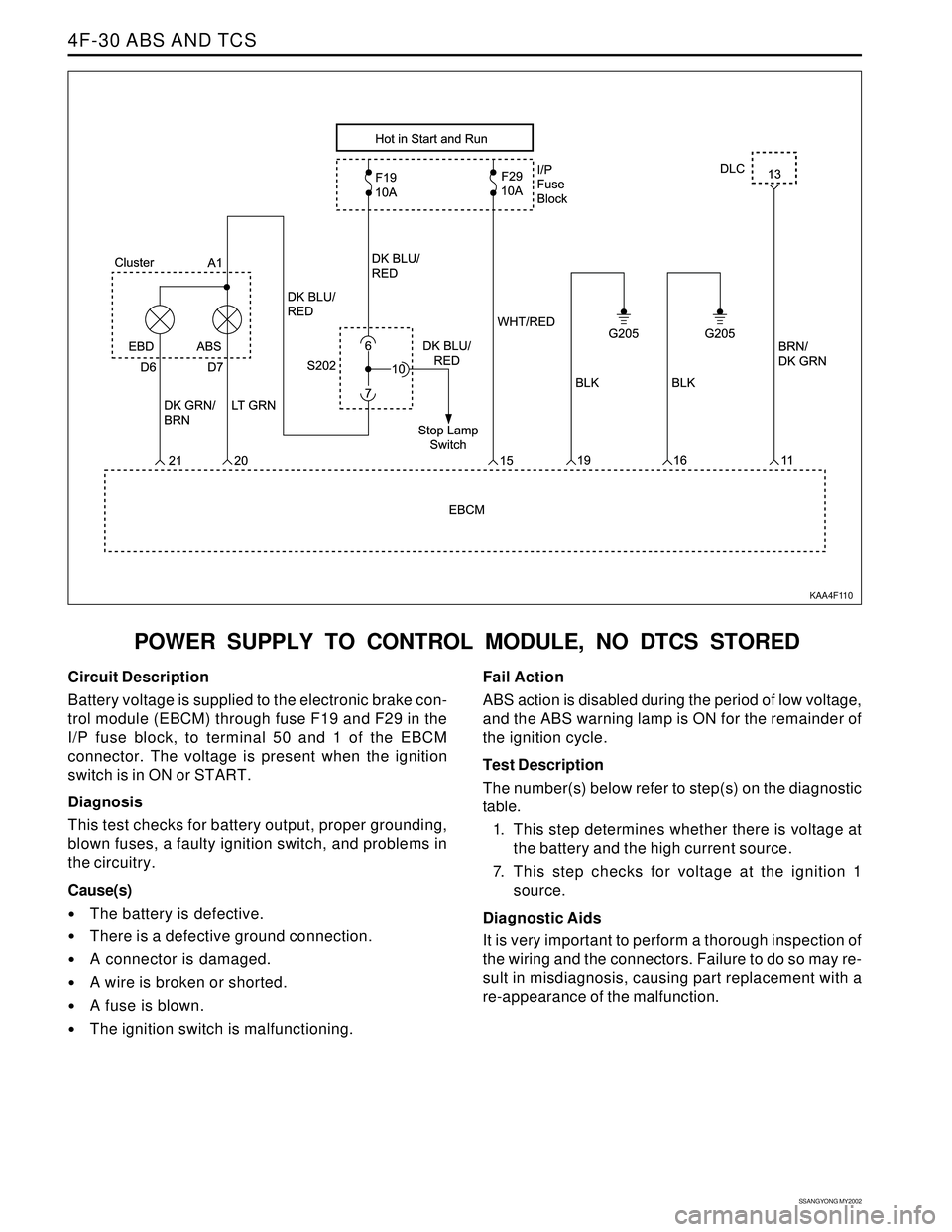
SSANGYONG MY2002
4F-30 ABS AND TCS
POWER SUPPLY TO CONTROL MODULE, NO DTCS STORED
KAA4F110
Circuit Description
Battery voltage is supplied to the electronic brake con-
trol module (EBCM) through fuse F19 and F29 in the
I/P fuse block, to terminal 50 and 1 of the EBCM
connector. The voltage is present when the ignition
switch is in ON or START.
Diagnosis
This test checks for battery output, proper grounding,
blown fuses, a faulty ignition switch, and problems in
the circuitry.
Cause(s)
The battery is defective.
There is a defective ground connection.
A connector is damaged.
A wire is broken or shorted.
A fuse is blown.
The ignition switch is malfunctioning.Fail Action
ABS action is disabled during the period of low voltage,
and the ABS warning lamp is ON for the remainder of
the ignition cycle.
Test Description
The number(s) below refer to step(s) on the diagnostic
table.
1. This step determines whether there is voltage at
the battery and the high current source.
7. This step checks for voltage at the ignition 1
source.
Diagnostic Aids
It is very important to perform a thorough inspection of
the wiring and the connectors. Failure to do so may re-
sult in misdiagnosis, causing part replacement with a
re-appearance of the malfunction.
Page 1014 of 2053
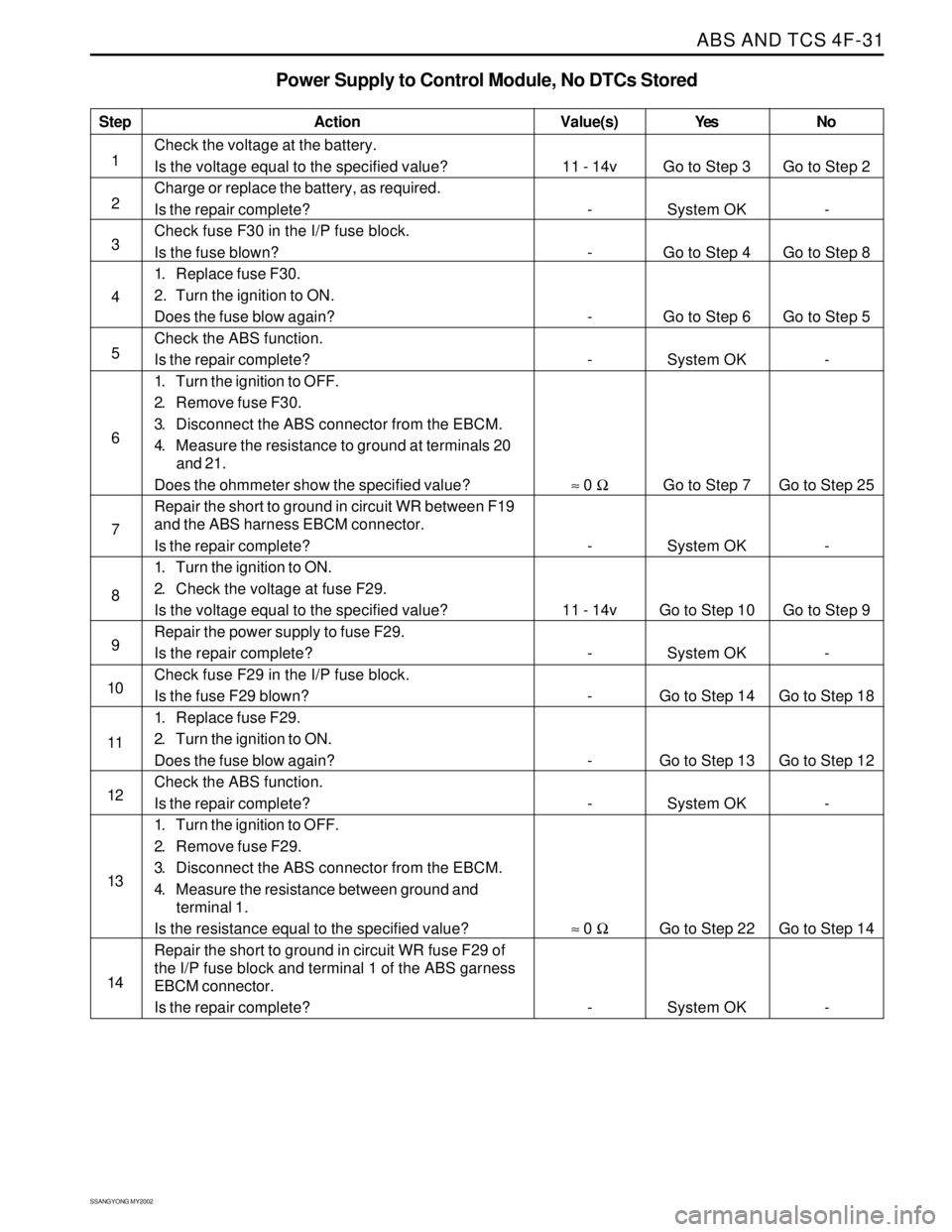
ABS AND TCS 4F-31
SSANGYONG MY2002
Step
1
2
3
4
5
6
7
8
9
10
11
12
13
14
Power Supply to Control Module, No DTCs Stored
Action
Go to Step 3
System OK
Go to Step 4
Go to Step 6
System OK
Go to Step 7
System OK
Go to Step 10
System OK
Go to Step 14
Go to Step 13
System OK
Go to Step 22
System OKGo to Step 2
-
Go to Step 8
Go to Step 5
-
Go to Step 25
-
Go to Step 9
-
Go to Step 18
Go to Step 12
-
Go to Step 14
- 11 - 14v
-
-
-
-
≈ 0 Ω
-
11 - 14v
-
-
-
-
≈ 0 Ω
-
Check the voltage at the battery.
Is the voltage equal to the specified value?
Charge or replace the battery, as required.
Is the repair complete?
Check fuse F30 in the I/P fuse block.
Is the fuse blown?
1. Replace fuse F30.
2. Turn the ignition to ON.
Does the fuse blow again?
Check the ABS function.
Is the repair complete?
1. Turn the ignition to OFF.
2. Remove fuse F30.
3. Disconnect the ABS connector from the EBCM.
4. Measure the resistance to ground at terminals 20
and 21.
Does the ohmmeter show the specified value?
Repair the short to ground in circuit WR between F19
and the ABS harness EBCM connector.
Is the repair complete?
1. Turn the ignition to ON.
2. Check the voltage at fuse F29.
Is the voltage equal to the specified value?
Repair the power supply to fuse F29.
Is the repair complete?
Check fuse F29 in the I/P fuse block.
Is the fuse F29 blown?
1. Replace fuse F29.
2. Turn the ignition to ON.
Does the fuse blow again?
Check the ABS function.
Is the repair complete?
1. Turn the ignition to OFF.
2. Remove fuse F29.
3. Disconnect the ABS connector from the EBCM.
4. Measure the resistance between ground and
terminal 1.
Is the resistance equal to the specified value?
Repair the short to ground in circuit WR fuse F29 of
the I/P fuse block and terminal 1 of the ABS garness
EBCM connector.
Is the repair complete?
Value(s) Yes No
Page 1015 of 2053
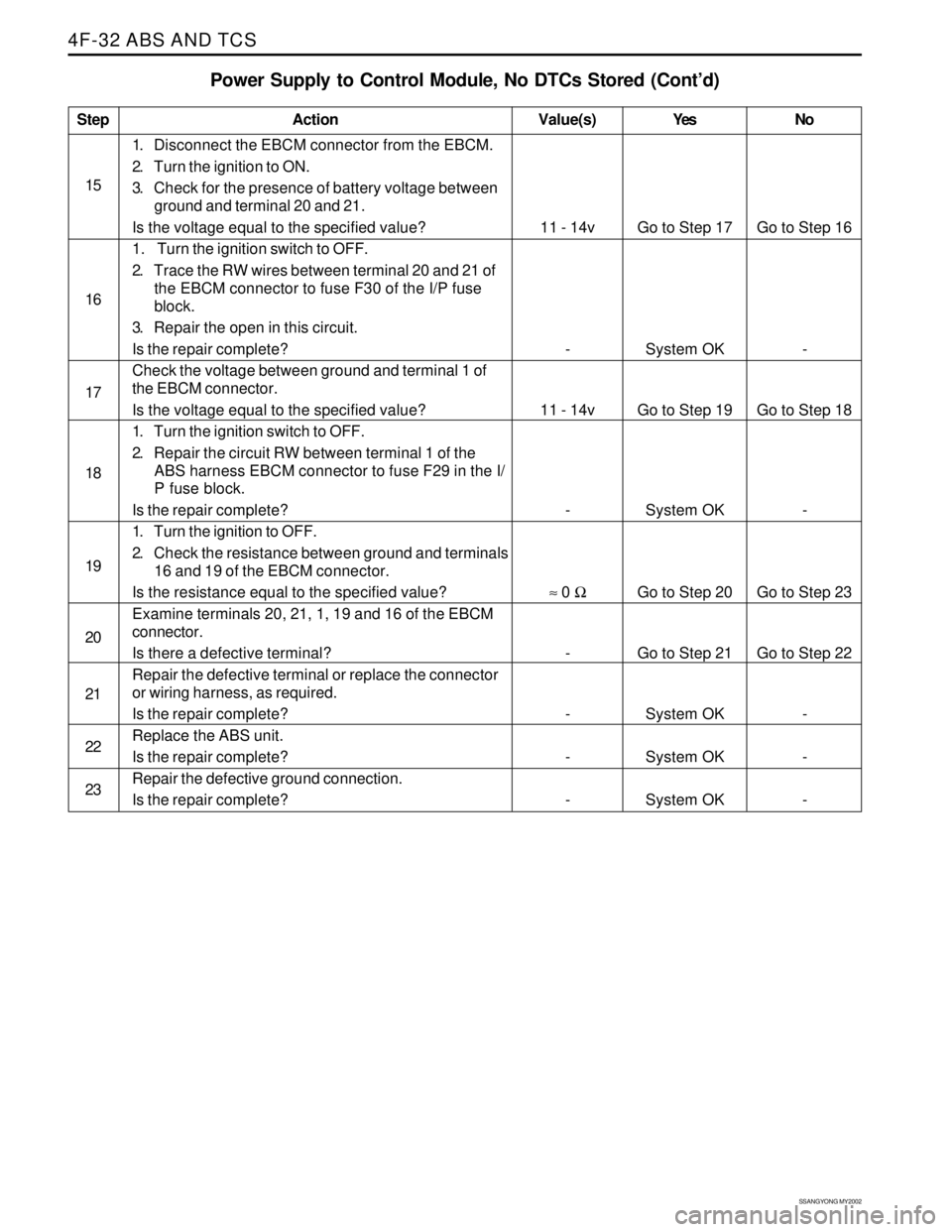
SSANGYONG MY2002
4F-32 ABS AND TCS
Step
15
16
17
18
19
20
21
22
23
Power Supply to Control Module, No DTCs Stored (Cont’d)
Action
Go to Step 17
System OK
Go to Step 19
System OK
Go to Step 20
Go to Step 21
System OK
System OK
System OKGo to Step 16
-
Go to Step 18
-
Go to Step 23
Go to Step 22
-
-
- 11 - 14v
-
11 - 14v
-
≈ 0 Ω
-
-
-
-
1. Disconnect the EBCM connector from the EBCM.
2. Turn the ignition to ON.
3. Check for the presence of battery voltage between
ground and terminal 20 and 21.
Is the voltage equal to the specified value?
1. Turn the ignition switch to OFF.
2. Trace the RW wires between terminal 20 and 21 of
the EBCM connector to fuse F30 of the I/P fuse
block.
3. Repair the open in this circuit.
Is the repair complete?
Check the voltage between ground and terminal 1 of
the EBCM connector.
Is the voltage equal to the specified value?
1. Turn the ignition switch to OFF.
2. Repair the circuit RW between terminal 1 of the
ABS harness EBCM connector to fuse F29 in the I/
P fuse block.
Is the repair complete?
1. Turn the ignition to OFF.
2. Check the resistance between ground and terminals
16 and 19 of the EBCM connector.
Is the resistance equal to the specified value?
Examine terminals 20, 21, 1, 19 and 16 of the EBCM
connector.
Is there a defective terminal?
Repair the defective terminal or replace the connector
or wiring harness, as required.
Is the repair complete?
Replace the ABS unit.
Is the repair complete?
Repair the defective ground connection.
Is the repair complete?
Value(s) Yes No
Page 1019 of 2053
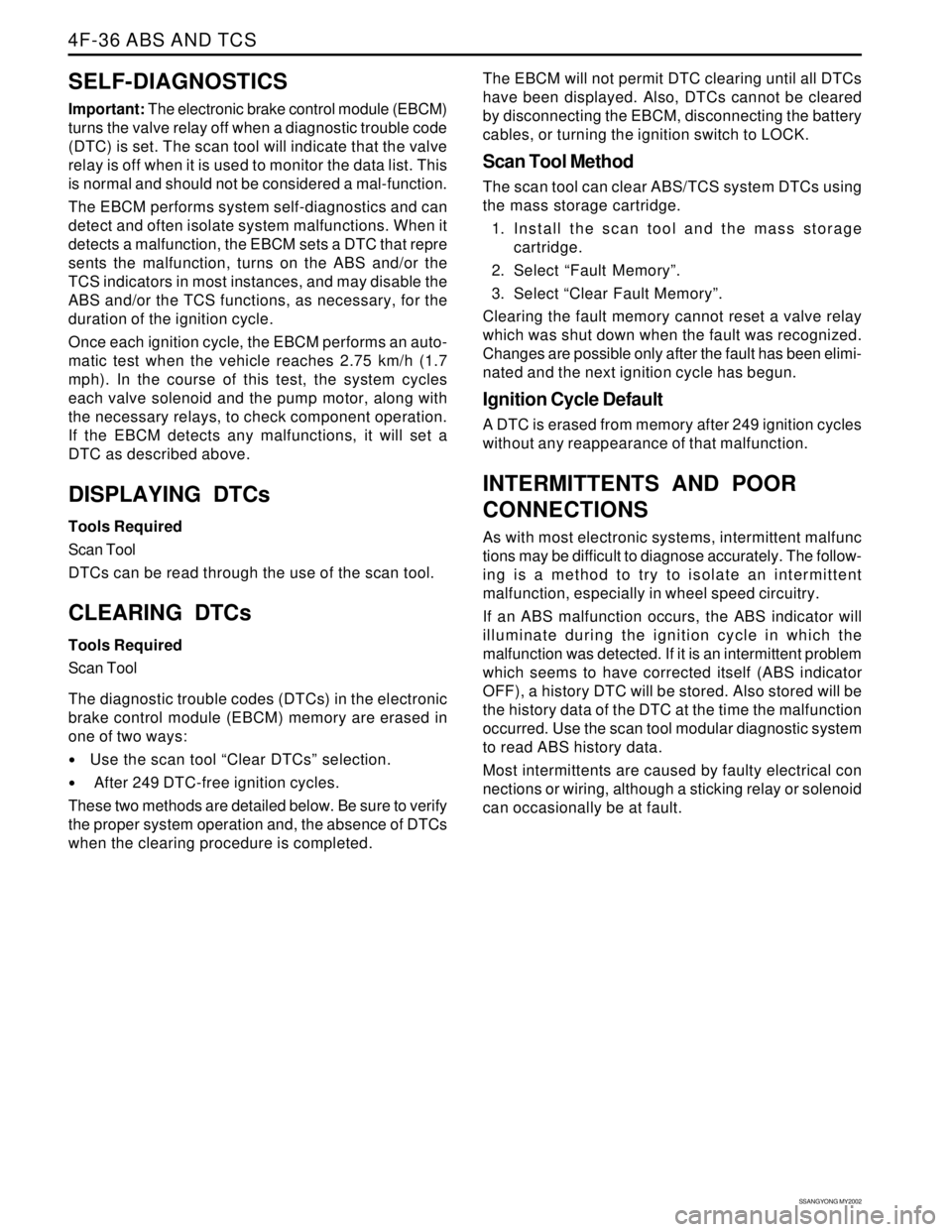
SSANGYONG MY2002
4F-36 ABS AND TCS
SELF-DIAGNOSTICS
Important: The electronic brake control module (EBCM)
turns the valve relay off when a diagnostic trouble code
(DTC) is set. The scan tool will indicate that the valve
relay is off when it is used to monitor the data list. This
is normal and should not be considered a mal-function.
The EBCM performs system self-diagnostics and can
detect and often isolate system malfunctions. When it
detects a malfunction, the EBCM sets a DTC that repre
sents the malfunction, turns on the ABS and/or the
TCS indicators in most instances, and may disable the
ABS and/or the TCS functions, as necessary, for the
duration of the ignition cycle.
Once each ignition cycle, the EBCM performs an auto-
matic test when the vehicle reaches 2.75 km/h (1.7
mph). In the course of this test, the system cycles
each valve solenoid and the pump motor, along with
the necessary relays, to check component operation.
If the EBCM detects any malfunctions, it will set a
DTC as described above.
DISPLAYING DTCs
Tools Required
Scan Tool
DTCs can be read through the use of the scan tool.
CLEARING DTCs
Tools Required
Scan Tool
The diagnostic trouble codes (DTCs) in the electronic
brake control module (EBCM) memory are erased in
one of two ways:
Use the scan tool “Clear DTCs” selection.
After 249 DTC-free ignition cycles.
These two methods are detailed below. Be sure to verify
the proper system operation and, the absence of DTCs
when the clearing procedure is completed.The EBCM will not permit DTC clearing until all DTCs
have been displayed. Also, DTCs cannot be cleared
by disconnecting the EBCM, disconnecting the battery
cables, or turning the ignition switch to LOCK.
Scan Tool Method
The scan tool can clear ABS/TCS system DTCs using
the mass storage cartridge.
1. Install the scan tool and the mass storage
cartridge.
2. Select “Fault Memory”.
3. Select “Clear Fault Memory”.
Clearing the fault memory cannot reset a valve relay
which was shut down when the fault was recognized.
Changes are possible only after the fault has been elimi-
nated and the next ignition cycle has begun.
Ignition Cycle Default
A DTC is erased from memory after 249 ignition cycles
without any reappearance of that malfunction.
INTERMITTENTS AND POOR
CONNECTIONS
As with most electronic systems, intermittent malfunc
tions may be difficult to diagnose accurately. The follow-
ing is a method to try to isolate an intermittent
malfunction, especially in wheel speed circuitry.
If an ABS malfunction occurs, the ABS indicator will
illuminate during the ignition cycle in which the
malfunction was detected. If it is an intermittent problem
which seems to have corrected itself (ABS indicator
OFF), a history DTC will be stored. Also stored will be
the history data of the DTC at the time the malfunction
occurred. Use the scan tool modular diagnostic system
to read ABS history data.
Most intermittents are caused by faulty electrical con
nections or wiring, although a sticking relay or solenoid
can occasionally be at fault.
Page 1022 of 2053
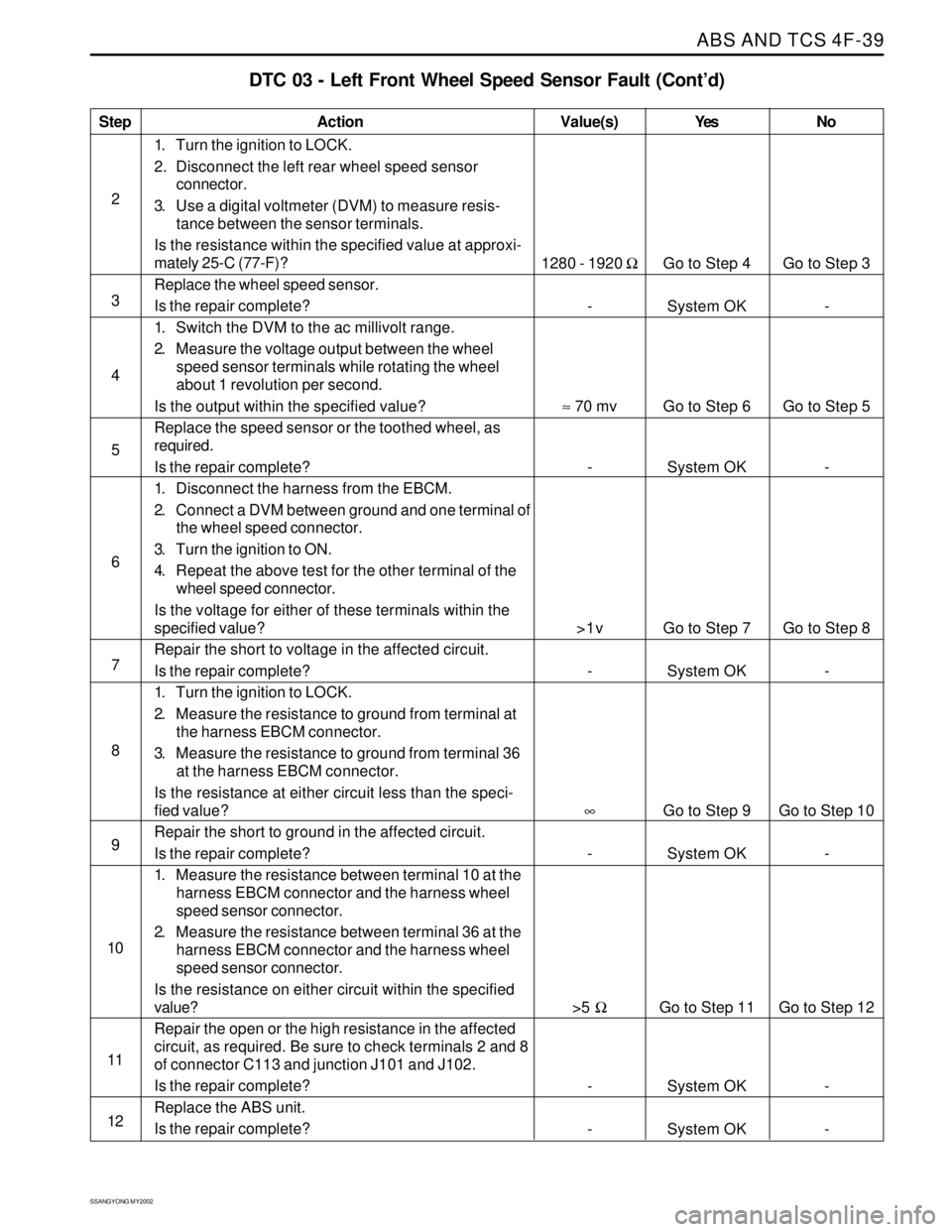
ABS AND TCS 4F-39
SSANGYONG MY2002
Step
2
3
4
5
6
7
8
9
10
11
12
DTC 03 - Left Front Wheel Speed Sensor Fault (Cont’d)
Action
Go to Step 4
System OK
Go to Step 6
System OK
Go to Step 7
System OK
Go to Step 9
System OK
Go to Step 11
System OK
System OKGo to Step 3
-
Go to Step 5
-
Go to Step 8
-
Go to Step 10
-
Go to Step 12
-
- 1280 - 1920 Ω
-
≈ 70 mv
-
>1v
-
∞
-
>5 Ω
-
-
1. Turn the ignition to LOCK.
2. Disconnect the left rear wheel speed sensor
connector.
3. Use a digital voltmeter (DVM) to measure resis-
tance between the sensor terminals.
Is the resistance within the specified value at approxi-
mately 25-C (77-F)?
Replace the wheel speed sensor.
Is the repair complete?
1. Switch the DVM to the ac millivolt range.
2. Measure the voltage output between the wheel
speed sensor terminals while rotating the wheel
about 1 revolution per second.
Is the output within the specified value?
Replace the speed sensor or the toothed wheel, as
required.
Is the repair complete?
1. Disconnect the harness from the EBCM.
2. Connect a DVM between ground and one terminal of
the wheel speed connector.
3. Turn the ignition to ON.
4. Repeat the above test for the other terminal of the
wheel speed connector.
Is the voltage for either of these terminals within the
specified value?
Repair the short to voltage in the affected circuit.
Is the repair complete?
1. Turn the ignition to LOCK.
2. Measure the resistance to ground from terminal at
the harness EBCM connector.
3. Measure the resistance to ground from terminal 36
at the harness EBCM connector.
Is the resistance at either circuit less than the speci-
fied value?
Repair the short to ground in the affected circuit.
Is the repair complete?
1. Measure the resistance between terminal 10 at the
harness EBCM connector and the harness wheel
speed sensor connector.
2. Measure the resistance between terminal 36 at the
harness EBCM connector and the harness wheel
speed sensor connector.
Is the resistance on either circuit within the specified
value?
Repair the open or the high resistance in the affected
circuit, as required. Be sure to check terminals 2 and 8
of connector C113 and junction J101 and J102.
Is the repair complete?
Replace the ABS unit.
Is the repair complete?
Value(s) Yes No
Page 1024 of 2053
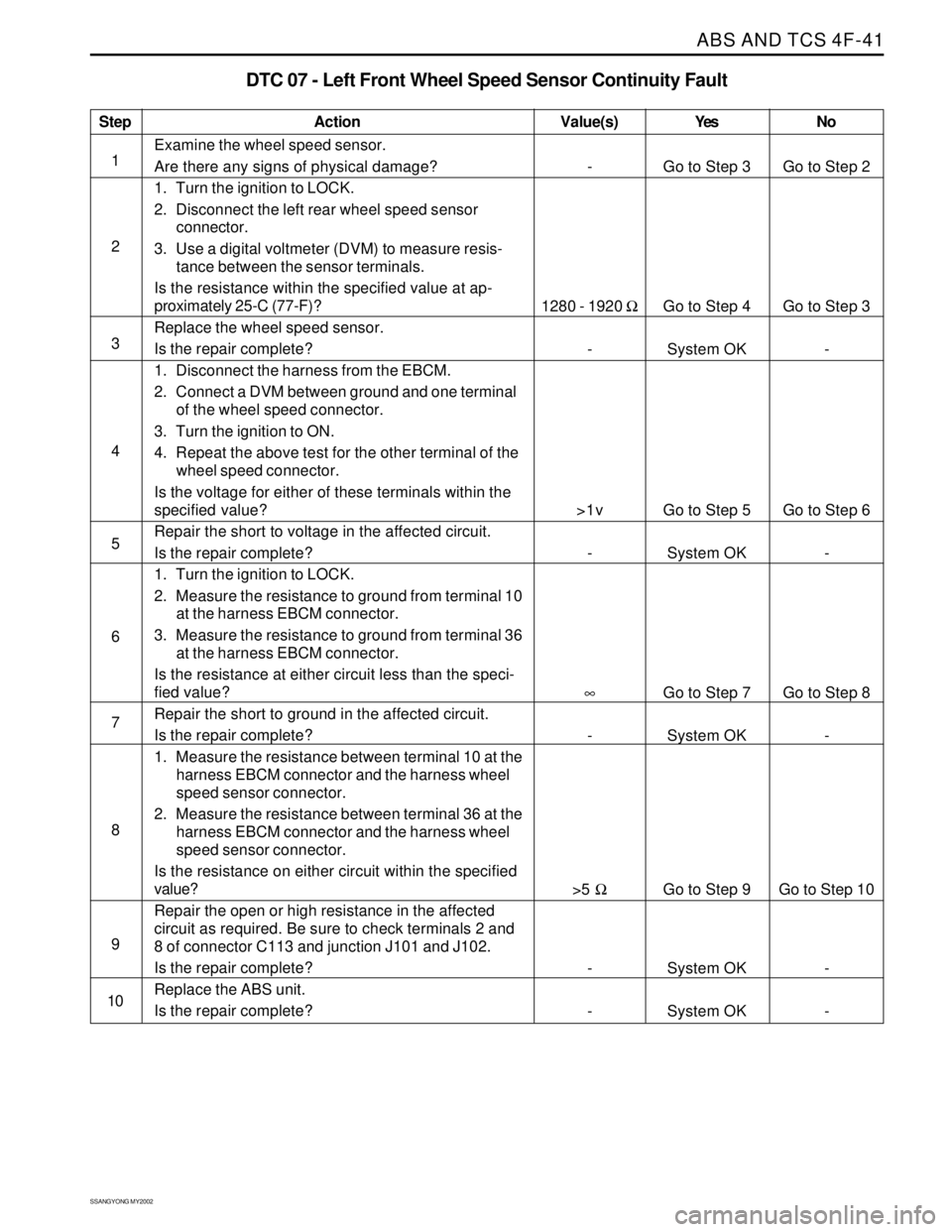
ABS AND TCS 4F-41
SSANGYONG MY2002
Step
1
2
3
4
5
6
7
8
9
10
DTC 07 - Left Front Wheel Speed Sensor Continuity Fault
Action
Go to Step 3
Go to Step 4
System OK
Go to Step 5
System OK
Go to Step 7
System OK
Go to Step 9
System OK
System OKGo to Step 2
Go to Step 3
-
Go to Step 6
-
Go to Step 8
-
Go to Step 10
-
- -
1280 - 1920 Ω
-
>1v
-
∞
-
>5 Ω
-
-
Examine the wheel speed sensor.
Are there any signs of physical damage?
1. Turn the ignition to LOCK.
2. Disconnect the left rear wheel speed sensor
connector.
3. Use a digital voltmeter (DVM) to measure resis-
tance between the sensor terminals.
Is the resistance within the specified value at ap-
proximately 25-C (77-F)?
Replace the wheel speed sensor.
Is the repair complete?
1. Disconnect the harness from the EBCM.
2. Connect a DVM between ground and one terminal
of the wheel speed connector.
3. Turn the ignition to ON.
4. Repeat the above test for the other terminal of the
wheel speed connector.
Is the voltage for either of these terminals within the
specified value?
Repair the short to voltage in the affected circuit.
Is the repair complete?
1. Turn the ignition to LOCK.
2. Measure the resistance to ground from terminal 10
at the harness EBCM connector.
3. Measure the resistance to ground from terminal 36
at the harness EBCM connector.
Is the resistance at either circuit less than the speci-
fied value?
Repair the short to ground in the affected circuit.
Is the repair complete?
1. Measure the resistance between terminal 10 at the
harness EBCM connector and the harness wheel
speed sensor connector.
2. Measure the resistance between terminal 36 at the
harness EBCM connector and the harness wheel
speed sensor connector.
Is the resistance on either circuit within the specified
value?
Repair the open or high resistance in the affected
circuit as required. Be sure to check terminals 2 and
8 of connector C113 and junction J101 and J102.
Is the repair complete?
Replace the ABS unit.
Is the repair complete?
Value(s) Yes No
Page 1026 of 2053
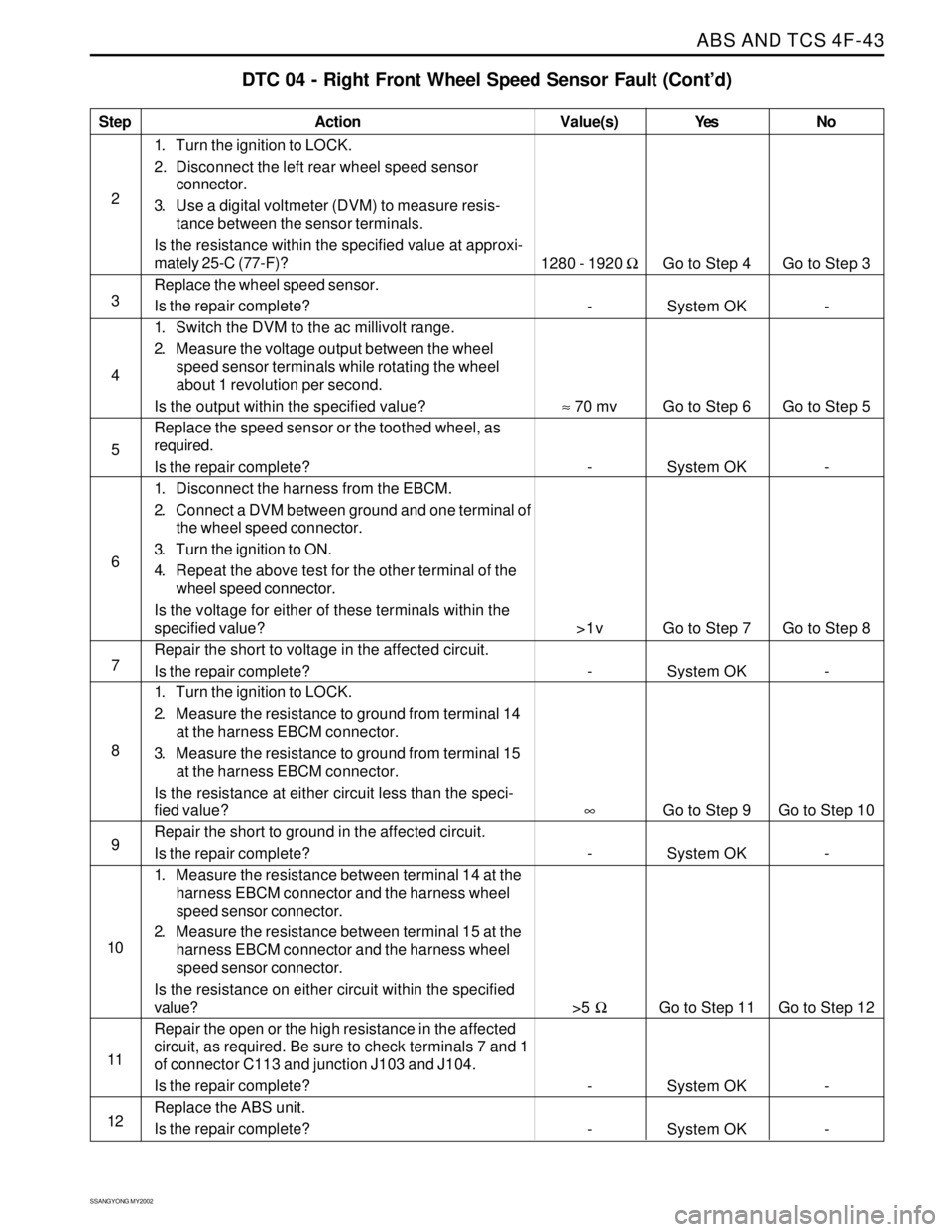
ABS AND TCS 4F-43
SSANGYONG MY2002
Step
2
3
4
5
6
7
8
9
10
11
12
DTC 04 - Right Front Wheel Speed Sensor Fault (Cont’d)
Action
Go to Step 4
System OK
Go to Step 6
System OK
Go to Step 7
System OK
Go to Step 9
System OK
Go to Step 11
System OK
System OKGo to Step 3
-
Go to Step 5
-
Go to Step 8
-
Go to Step 10
-
Go to Step 12
-
- 1280 - 1920 Ω
-
≈ 70 mv
-
>1v
-
∞
-
>5 Ω
-
-
1. Turn the ignition to LOCK.
2. Disconnect the left rear wheel speed sensor
connector.
3. Use a digital voltmeter (DVM) to measure resis-
tance between the sensor terminals.
Is the resistance within the specified value at approxi-
mately 25-C (77-F)?
Replace the wheel speed sensor.
Is the repair complete?
1. Switch the DVM to the ac millivolt range.
2. Measure the voltage output between the wheel
speed sensor terminals while rotating the wheel
about 1 revolution per second.
Is the output within the specified value?
Replace the speed sensor or the toothed wheel, as
required.
Is the repair complete?
1. Disconnect the harness from the EBCM.
2. Connect a DVM between ground and one terminal of
the wheel speed connector.
3. Turn the ignition to ON.
4. Repeat the above test for the other terminal of the
wheel speed connector.
Is the voltage for either of these terminals within the
specified value?
Repair the short to voltage in the affected circuit.
Is the repair complete?
1. Turn the ignition to LOCK.
2. Measure the resistance to ground from terminal 14
at the harness EBCM connector.
3. Measure the resistance to ground from terminal 15
at the harness EBCM connector.
Is the resistance at either circuit less than the speci-
fied value?
Repair the short to ground in the affected circuit.
Is the repair complete?
1. Measure the resistance between terminal 14 at the
harness EBCM connector and the harness wheel
speed sensor connector.
2. Measure the resistance between terminal 15 at the
harness EBCM connector and the harness wheel
speed sensor connector.
Is the resistance on either circuit within the specified
value?
Repair the open or the high resistance in the affected
circuit, as required. Be sure to check terminals 7 and 1
of connector C113 and junction J103 and J104.
Is the repair complete?
Replace the ABS unit.
Is the repair complete?
Value(s) Yes No
Page 1028 of 2053
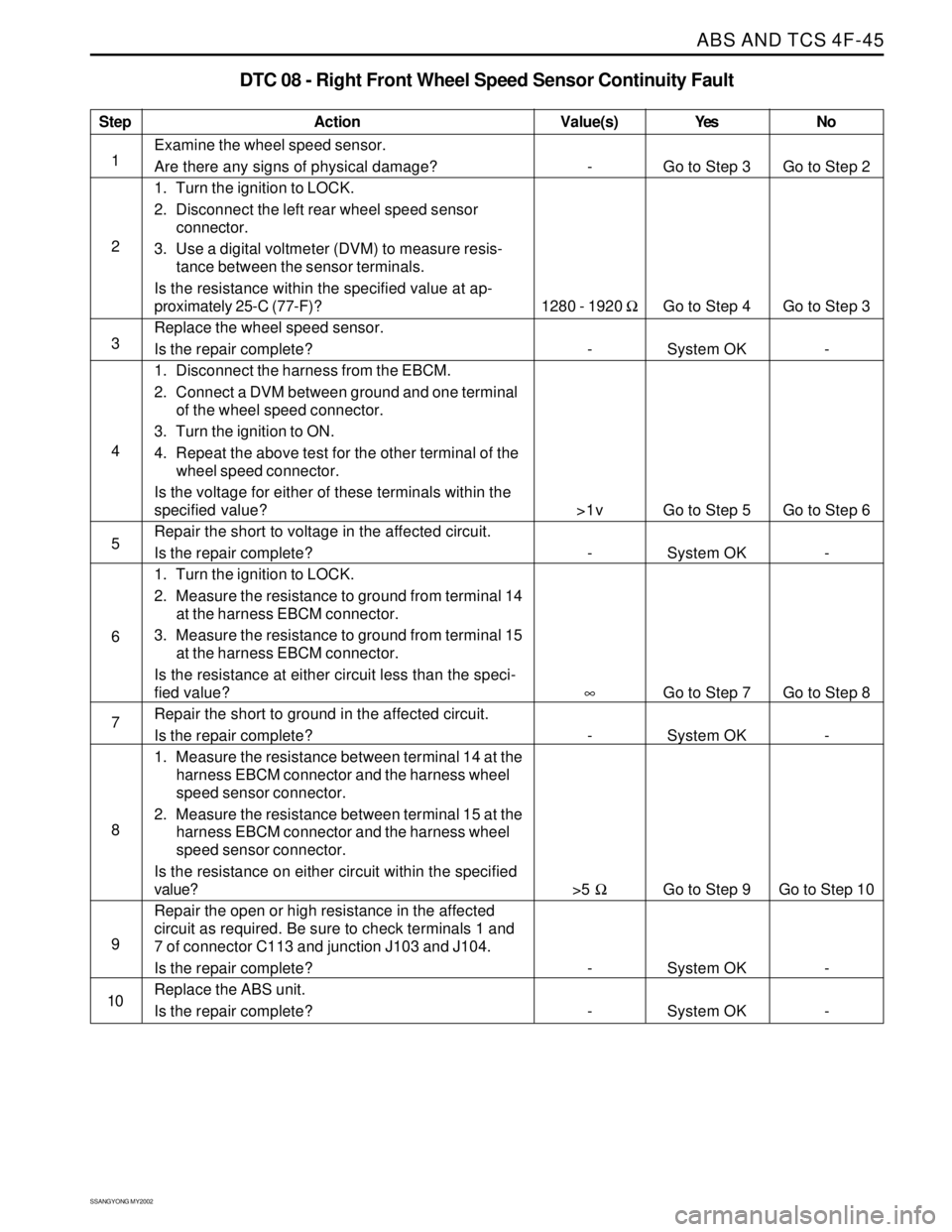
ABS AND TCS 4F-45
SSANGYONG MY2002
Step
1
2
3
4
5
6
7
8
9
10
DTC 08 - Right Front Wheel Speed Sensor Continuity Fault
Action
Go to Step 3
Go to Step 4
System OK
Go to Step 5
System OK
Go to Step 7
System OK
Go to Step 9
System OK
System OKGo to Step 2
Go to Step 3
-
Go to Step 6
-
Go to Step 8
-
Go to Step 10
-
- -
1280 - 1920 Ω
-
>1v
-
∞
-
>5 Ω
-
-
Examine the wheel speed sensor.
Are there any signs of physical damage?
1. Turn the ignition to LOCK.
2. Disconnect the left rear wheel speed sensor
connector.
3. Use a digital voltmeter (DVM) to measure resis-
tance between the sensor terminals.
Is the resistance within the specified value at ap-
proximately 25-C (77-F)?
Replace the wheel speed sensor.
Is the repair complete?
1. Disconnect the harness from the EBCM.
2. Connect a DVM between ground and one terminal
of the wheel speed connector.
3. Turn the ignition to ON.
4. Repeat the above test for the other terminal of the
wheel speed connector.
Is the voltage for either of these terminals within the
specified value?
Repair the short to voltage in the affected circuit.
Is the repair complete?
1. Turn the ignition to LOCK.
2. Measure the resistance to ground from terminal 14
at the harness EBCM connector.
3. Measure the resistance to ground from terminal 15
at the harness EBCM connector.
Is the resistance at either circuit less than the speci-
fied value?
Repair the short to ground in the affected circuit.
Is the repair complete?
1. Measure the resistance between terminal 14 at the
harness EBCM connector and the harness wheel
speed sensor connector.
2. Measure the resistance between terminal 15 at the
harness EBCM connector and the harness wheel
speed sensor connector.
Is the resistance on either circuit within the specified
value?
Repair the open or high resistance in the affected
circuit as required. Be sure to check terminals 1 and
7 of connector C113 and junction J103 and J104.
Is the repair complete?
Replace the ABS unit.
Is the repair complete?
Value(s) Yes No